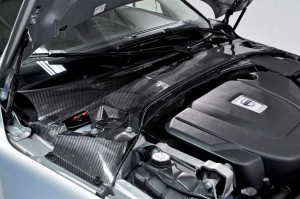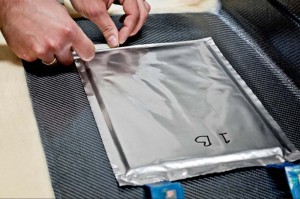
A Volvo S80 prototype embeds its nano batteries and ultra-capacitors inside carbon fiber body panels.
Battery cars have a number of potential advantages – including the ability to move the motor out from under the hood, something that could translate into a lot more space for passengers. On the downside, manufacturers struggle to find the right place to put bulky batteries that can eat up cargo and passenger space and, if poorly positioned, throw a vehicle’s weight balance horribly awry.
Volvo Car Group, the Swedish-based, Chinese-owned automaker, may have come up with an interesting alternative. The maker wants to build energy storage devices right into the body panels of vehicles like the prototype S80 shown here.
The experimental car is the culmination of a 3.5-year research project in which, Volvo says, “The project team identified a feasible solution to the heavy weight, large size and high costs associated with the batteries seen in hybrids and electric cars today, whilst maintaining the efficient capacity of power and performance.”
Now, several manufacturers have been tinkering with so-called “prismatic” lithium-ion and lithium-polymer batteries which are more flexible than the rigid cells used in the vast majority of today’s battery-based vehicles – never mind consumer electronics. Prismatic batteries can have a bit more flexibility to mold and form. But they still have their limitations. And they are nonetheless heavy.
Consider the way conventional batteries eat up space in today’s vehicles. The Chevrolet Volt’s passengers had to be placed around a large T-shaped pack. The new 2014 Honda Accord Hybrid sacrifices about 20% of the non-hybrid model’s cargo space and abandons its fold-down rear seats. The Tesla Model S mounts its batteries under the load floor but then requires a thick armor plate to shield the pack from damage – something not always possible, as proved by a recent fire caused by metal debris punching a 3-inch hole into the batteries.
(Click Here for the review of Honda’s new 2014 Accord Hybrid.)
Volvo’s approach actually would eliminate conventional batteries entirely, replacing them with a mix of nano batteries and even more exotic ultra-capacitors. These are an alternative storage technique that is just gaining traction. Mazda used ultra-capacitors in the e-Loop energy regeneration system developed as part of its new SkyActiv technology.
Volvo goes a step further by actually replacing conventional body panels with carbon fiber structures that contain ultra-capacitors and nano batteries inside them. Adds Volvo, “The reinforced carbon fiber (components) sandwich the new battery and are molded and formed to fit around the car’s frame, such as the door panels, the boot lid and wheel bowl, substantially saving on space.”
These energy storage devices can be recharged in much the same way as conventional batteries, by either using regenerative energy or by plugging into the electrical grid.
(Diesel, gas models dominate finalists list for Green Car of the Year. Click Here to see which battery model made the cut.)
Volvo claims the approach could reduce a battery-based vehicle’s weight by as much as 15%. It also claims the design would not only be “cost effective but would also have improvements to the impact on the environment.”
The cost issue remains to be seen and will likely raise some skeptical eyebrows. Carbon fiber components remain phenomenally expensive and slow to produce, a problem for a mass market manufacturer. Ultra-capacitors, in particular, are also expensive. And they generally store far less energy than a comparably sized battery.
Whether this approach will be more than a research lab curiosity or can actually be transferred to an assembly line remains to be seen.


Wow, do I see all sorts of electrical and fire safety issues with batteries within body panels, especially carbon fiber panels. This stuff might sound great at first until engineers look at all of the aspects to the proposed design changes.
Can you imagine what is likely to happen when one of these panels is smashed together in an auto accident? Ever seen what happens when carbon fiber catches fire? Do most people understand that CF is electrically conductive? FYI – Race cars that use CF typically have onboard fire extinguishing systems and they still tend to burn to the ground once a fire starts.